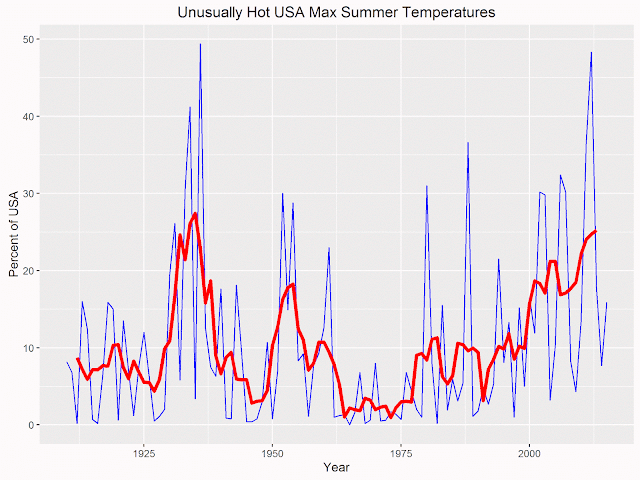Following on from my last post here's another interesting example of Tony Heller using odd statistics to make a point. In this case however it isn't so much the oddness of his statistics that are a problem, it's his entire argument. The post in question The Trouble With Satellites, which claims that satellites are exaggerating global warming by starting at an exceptionally cold period. It's a long post, but the only meat is in the first couple and final paragraphs, and can be summarized thus:
- Whilst Satellite data is
infinitely
better than surface data, it has a major problem in only going back to 1979. - This was the coldest period in the US in the last 90 years, and so any rise in temperatures since then is misleading.
- Therefore Heller sees
little or no evidence that Earth is warmer now than it was in 1940.
The first point is debatable - Heller obviously prefers satellites because they show slightly less warming especially this century - but both satellite and surface data have different problems and where there are differences there's no good reason to assume one must be correct and the other wrong. But I agree that one advantage surface data has over satellites is their longer reach. That satellites only going back 40 years makes it difficult to put any differences in perspective.
It's the second point that is the main problem. Heller says:
But there is a huge problem with satellite temperatures. They start in 1979, which was the coldest period of the last 90 years in the US. The frequency of below 0F (-18C) nights peaked in 1979, and then dropped in half by the year 2000, before starting to increase again.
One obvious problem here is that, as always he's only looking at the US, which tells us little about global temperatures.
Even then, Heller is vague about what he means by 1979 being the coldest period
in 90 years.
His graph shows a 5 year rolling average of the percentage of days below 0°F, that's around -18°C in real money.
As with his hot summer data this is a dubious way of measuring how cold the US was around 1979;
obviously it's only going to show winter weather, and it will only be a small part of the US that will affect the graph.
As it happens, he didn't really need to go to all the trouble of inventing weird measures. NOAA's own website shows that 1979 was indeed the coldest winter on record, not just in the last 90 years. Beating the previous record set in 1936 by over 1°F.

Even if, more logically, we look at the whole year, 1979 was also cold in the USA. Annual US temperature Not quite the coldest in 90 years (1929 beats it by a smidgen), but pretty much.
But if we look at the 5 year average, as Heller seems to be, we see that the first 5 years of the satellite era (1979-1983), was not at all the coldest period in the last 90 years.

But if we don't put America first, and instead look at global temperatures, the first 5 years of the satellite era were at a local high, warmer than the warm 1940s.

Heller's claim that satellites started at the coldest period of the last 90 years
, is meaningless.
As far as hi closing remark that he can see no evidence that current temperatures are warmer than the 40s, this may well be correct as far as Heller's eyes are concerned. I assume he's not looking very hard, and can easily disregard any evidence to the contrary as fraud. But as an example that there is some evidence that temperatures are warmer than the 40s, we can use Heller's own technique of aligning 5 year averages at the start of the satellite era.

Satellite temperatures are around 0.4°C above the mid-40s peak. If we do what Heller seems to prefer and use land only data the warming is even greater compared with the 40s; around 0.7°C warmer.

One final point though, using the first 5 years of the satellite data as a base point is not logical. It makes an assumption that satellite and surface data precisely agreed with each other at the start and have been drifting apart ever since. But there's no reason to suppose the years 1979-83 were the the same - it's just as plausible that the satellites were too high (or the surface too low) at the start and are becoming more accurate later. In fact this seems quite likely when you consider that the first 5 years include a strong El Niño, and satellites usually show more warming than surface data during El Niños. Changing the offset slightly can produce a slightly more consistent comparison.





